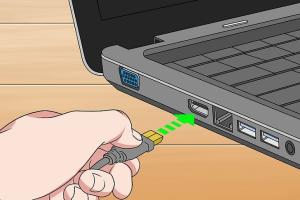Ultimate Guide to Connecting Your Laptop to a Monitor: Step-by-Step Instructions

-
Quick Links:
- Introduction
- Understanding Connection Types
- Step-by-Step Guide to Connect Your Laptop to a Monitor
- Setting Up Your Display
- Troubleshooting Common Issues
- Advanced Tips for Multi-Monitor Setup
- Case Studies
- Expert Insights
- FAQs
Introduction
Connecting a laptop to a monitor can enhance your productivity, improve your viewing experience, and allow for a multi-tasking environment. Whether you're a remote worker looking to extend your workspace or a gamer wanting a larger screen, this guide will help you through every step of the process.
Understanding Connection Types
Before diving into the connection process, it’s essential to understand the various connection types available for laptops and monitors. Here are the most common connection types:
- HDMI (High-Definition Multimedia Interface): The most common connection type for modern laptops and monitors, supporting both video and audio.
- DisplayPort: Often found on higher-end monitors, it supports high resolutions and refresh rates.
- DVI (Digital Visual Interface): An older connection type mainly used for video only.
- VGA (Video Graphics Array): An analog connection used primarily with older monitors.
- USB-C: A versatile connection type that can carry video and power, commonly used in newer laptops.
Step-by-Step Guide to Connect Your Laptop to a Monitor
Follow these steps to connect your laptop to a monitor effectively:
Step 1: Gather Necessary Equipment
- Monitor with compatible input ports
- Appropriate cable (HDMI, DisplayPort, etc.)
- Laptop with compatible output ports
- Power source for the monitor
Step 2: Connect the Cable
Begin by connecting one end of the cable to your laptop and the other end to the monitor. Ensure that the connections are tight to avoid any interruptions.
Step 3: Power on the Monitor
After connecting the cable, power on the monitor. You should see a splash screen indicating that the monitor is on.
Step 4: Adjust Display Settings
On your laptop, right-click on the desktop and select 'Display settings.' You can choose to extend or duplicate your display:
- Duplicate: Shows the same content on both screens.
- Extend: Expands your workspace across both screens, allowing you to move windows between them.
Step 5: Fine-tune Resolution Settings
Make sure to adjust the resolution settings according to the monitor’s specifications for optimal viewing experience.
Setting Up Your Display
Once connected, you may want to customize the display settings further. Here are some options:
- Orientation: Change the display from landscape to portrait mode.
- Multiple Displays: Set which display is primary.
- Scaling: Adjust the size of text, apps, and other items.
Troubleshooting Common Issues
Sometimes, you may encounter issues when connecting your laptop to a monitor. Here are some common problems and their solutions:
- No signal: Check connections and ensure the monitor is powered on.
- Incorrect display resolution: Adjust the resolution in display settings.
- Flickering screen: Try changing the cable or port.
Advanced Tips for Multi-Monitor Setup
If you’re looking to set up multiple monitors, here are some advanced tips:
- Utilize a docking station for multiple connections.
- Use monitors with similar resolutions for a seamless experience.
- Experiment with display arrangements in settings for optimal workflow.
Case Studies
Let’s look at a few case studies to see how connecting a laptop to a monitor can enhance productivity:
Case Study 1: Graphic Designer
A graphic designer improved their workflow by connecting a high-resolution monitor to their laptop, allowing for more accurate color representation and larger workspaces.
Case Study 2: Remote Worker
A remote worker found that using a dual-monitor setup increased their productivity by 30%, as they could easily reference documents while working on projects.
Expert Insights
We consulted tech experts to gain insights on the benefits of connecting laptops to monitors:
"Using an external monitor can significantly enhance your productivity, especially for tasks that require multiple applications at once." – Tech Expert, John Doe.
FAQs
1. Can I connect my laptop to any monitor?
As long as the monitor has a compatible input port, you can connect it to your laptop.
2. What should I do if my laptop doesn’t recognize the monitor?
Ensure the cable is connected properly and check if the monitor is powered on. You may also need to adjust display settings.
3. Is it possible to connect multiple monitors to one laptop?
Yes, many laptops support multiple monitors through various connection types or docking stations.
4. How do I switch between my laptop screen and the external monitor?
You can switch between displays using the display settings on your laptop or using keyboard shortcuts (like Windows + P on Windows machines).
5. What if my external monitor has a different resolution?
Adjust the resolution settings in your display settings to match the external monitor for optimal performance.
6. Can I use a TV as a monitor for my laptop?
Yes, as long as the TV has the appropriate input ports (HDMI is most common), it can function as a monitor.
7. How do I connect a laptop to a monitor wirelessly?
Use technologies like Miracast or Chromecast, depending on your laptop and monitor capabilities.
8. Will connecting to a monitor drain my laptop's battery faster?
Connecting to an external monitor can consume more power, potentially leading to faster battery drain if not plugged in.
9. What cable do I need to connect my laptop to a monitor?
The cable you need depends on the output port of your laptop and the input port of your monitor. Common types include HDMI, DisplayPort, and USB-C.
10. Can I connect a laptop to a monitor without a cable?
Yes, you can connect wirelessly using compatible devices and technologies like Miracast or Apple AirPlay.
By following this comprehensive guide, you will be able to connect your laptop to a monitor efficiently and troubleshoot any issues that may arise. Enhancing your workspace has never been easier!